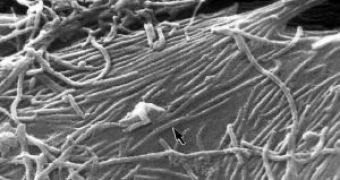In a decade long study, scientists linked outbreaks of Ebola hemorrhagic fever in human and wildlife in Gabon and neighboring area of northwestern Republic of Congo, but showed that climate also plays a role in spreading the disease.
The researchers discovered that many additional wildlife and human populations within and outside of known epidemic zones have been exposed to the virus, and the spread of Ebola no longer appeared as erratic and mysterious.
"Some researchers have hypothesized that outbreaks of Ebola are randomly-spaced periodic outbursts, while others have suggested that Ebola has spread like a wave surging over the Central African landscape," said Sally Lahm, a visiting scholar in UCSD's Division of Biological Sciences.
"Our results are intermediate between these two views. There is a perceived pattern to the way the virus spreads, but it is not simply a wave affecting everything in its path, since apparently healthy mammal communities thrived in close proximity to Ebola epidemic sites."
Between 1994 and 2003, she monitored reports of animal disease and deaths from wildlife survey teams, villagers, hunters, fishers, loggers, miners, Ebola survivors and families of victims from Ebola affected areas.
Finding dead animals in the humid tropical forests covering most of the area is a difficult task as animals, insects and rapid decomposition finish quickly any corpse.
The team received and verified reports on 397 carcasses, including gorillas, chimpanzees, mandrills, bush pigs, porcupines and four antelope species.
Bats are the main suspect as being the reservoir of the virus (they carry the infection without having severe symptoms and spread the virus to other species).
14 tested decomposed carcasses proved negative to Ebola virus (photo), but at 12 sites, observers also saw sick or dying animals with Ebola infection symptoms and 16 reported wildlife mortality events coincided with known Ebola bursts.
"The transmission of Ebola within animal populations is much more widespread than previously believed," explained Lahm.
"Ebola appears to spread both within species and between different species of animals."
It is thought that changes in human activity are behind the Ebola outbreaks, like new mining operations deep in forests and the eating of primate meat, but nobody knows the true origin.
Robert Swanepoel, the director of the Special Pathogens Branch of the National Institute of Communicable Diseases in Sandringham, South Africa, found 14 human blood samples positive for Ebola antibodies from 1000 samples collected in Gabon between 1981 and 1997.
Some of the people had been infected at least three years before the first known Ebola outbreak in Gabon, while other people were from regions where no known epidemics had occurred.
6 of the Ebola positive determined persons were identified and it was found that some of them had never visited a region with human Ebola outbreaks.
Thus people have been infected with Ebola virus where it has not been recognized.
This study linked Ebola outbreaks in humans and wildlife in Gabon and Congo that initially seemed disparate and unrelated.
The virus seems to have passed to humans first in southwest Gabon and from there, it spread to western and central Gabon and ultimately in Congo.
"If the spread of the Ebola virus follows its current northeastward path, the next outbreak would be expected to occur in northern Republic of the Congo towards Cameroon and the Central African Republic," said Lahm.
However, this seems to be influenced by climate: periods of prolonged drought-like conditions in the rainforest put a stress on animal populations, easing the disease infection.
Public education could decrease human contact with infected wildlife by discouraging people from scavenging dead animals and by promoting safe hunting, as Ebola seems to be more frequent in wildlife than thought.
About how Ebola virus spreads within and between mammal species, this remains a puzzle for scientists.

 14 DAY TRIAL //
14 DAY TRIAL //